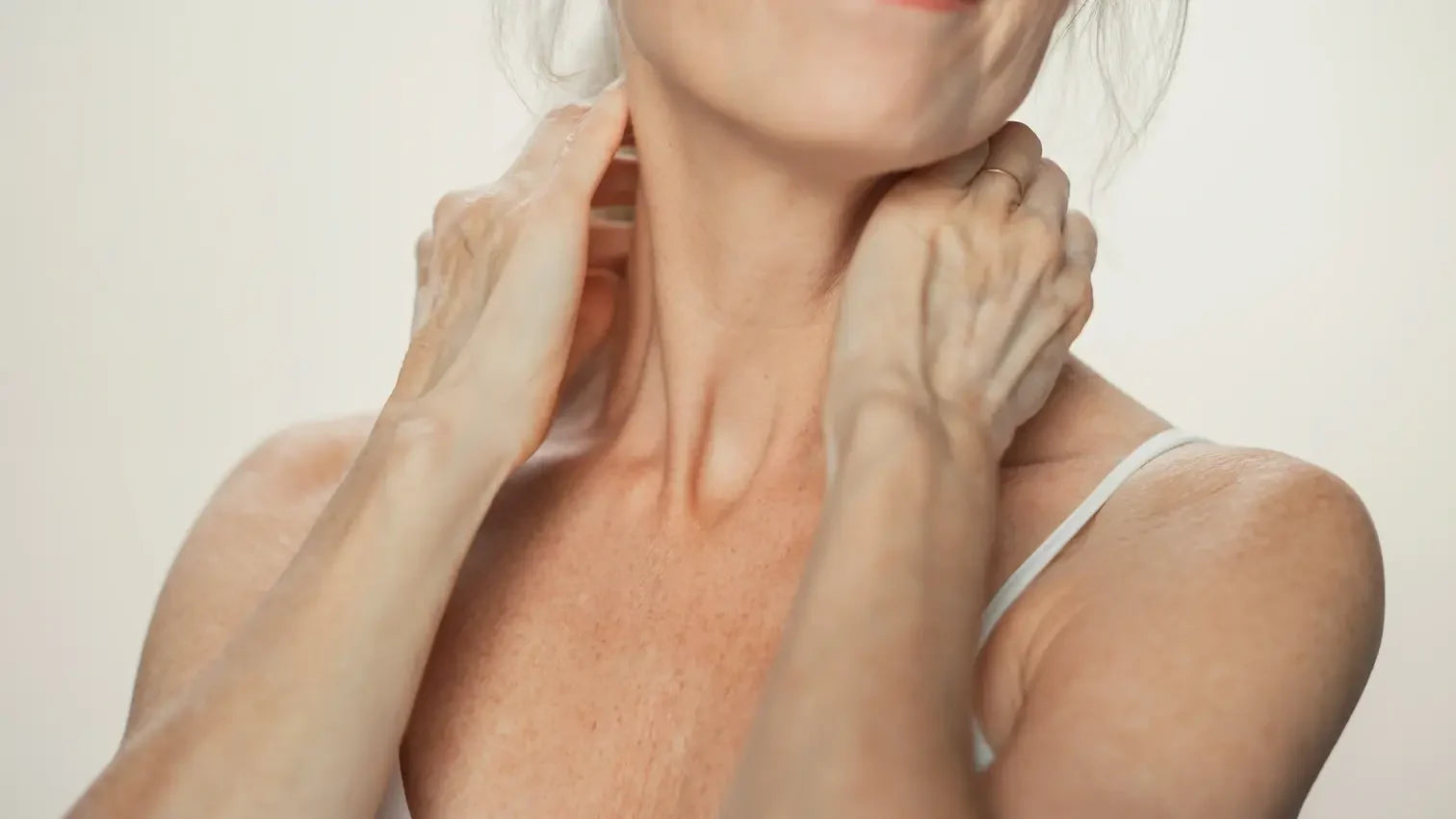How is the Skin on the Neck, Décolletage, and Hands Different?
This Skin Gets Thinner with Age
How is the Skin on the Neck, Décolletage, and Hands Different?
This Skin Gets Thinner with Age
This Skin Loses Moisture Easily
- Frequent washing of hands can strip away moisture, leaving skin rough and crepey (3)
- Exposure to environmental factors compromise the skin barrier further, leaving it even drier (6)
This Skin Loses Moisture Easily
- Frequent washing of hands can strip away moisture, leaving skin rough and crepey (3)
- Exposure to environmental factors compromise the skin barrier further, leaving it even drier (6)
This Skin is Highly Exposed
- UV exposure can damage the DNA in skin cells and break down collagen and elastin proteins, causing the skin to lose its firmness and elasticity. (7)
- With time, the accumulation of UV-induced senescent (aka zombie) cells contribute to further collagen degradation.
This Skin is Highly Exposed
- UV exposure can damage the DNA in skin cells and break down collagen and elastin proteins, causing the skin to lose its firmness and elasticity. (7)
- With time, the accumulation of UV-induced senescent (aka zombie) cells contribute to further collagen degradation.
3 Ways to Care for this Delicate Skin
1. Sun Protection
3 Ways to Care for this Delicate Skin
1. Sun Protection
2. Topical Supplements
2. Topical Supplements
Harmful Ingredients in Sunscreens: What You Need to Know
3. At Home Devices
3. At Home Devices
- The neck, décolletage, and hands are often neglected in skincare routines but are just as prone to sun damage, environmental stressors, and aging as the face.
- The skin in these areas is thinner and has fewer sebaceous glands, collagen, and elastin, making it more susceptible to dryness, wrinkles, and signs of aging.
- Using broad-spectrum sunscreen with at least SPF 30 on these areas, reapplying every 2 hours, and wearing protective clothing can help prevent UV damage.
- Skin care products that boost collagen and hyaluronic acid production can improve the skin's barrier function and prevent wrinkles and sagging.
- Non-fractional laser therapies like the at-home NIRA lasers can painlessly stimulate collagen production without causing burns or inflammation. Combining these treatments with the OS-01 peptide can enhance collagen production and reduce the appearance of wrinkles on the neck, décolletage, and hands.
- The neck, décolletage, and hands are often neglected in skincare routines but are just as prone to sun damage, environmental stressors, and aging as the face.
- The skin in these areas is thinner and has fewer sebaceous glands, collagen, and elastin, making it more susceptible to dryness, wrinkles, and signs of aging.
- Using broad-spectrum sunscreen with at least SPF 30 on these areas, reapplying every 2 hours, and wearing protective clothing can help prevent UV damage.
- Skin care products that boost collagen and hyaluronic acid production can improve the skin's barrier function and prevent wrinkles and sagging.
- Non-fractional laser therapies like the at-home NIRA lasers can painlessly stimulate collagen production without causing burns or inflammation. Combining these treatments with the OS-01 peptide can enhance collagen production and reduce the appearance of wrinkles on the neck, décolletage, and hands.
- https://www.jaad.org/article/S0190-9622(16)00242-5/abstract
- https://www.ncbi.nlm.nih.gov/books/NBK562229/
- https://www.ncbi.nlm.nih.gov/pmc/articles/PMC10063163/
- https://www.ncbi.nlm.nih.gov/pmc/articles/PMC5788262/
- https://www.ncbi.nlm.nih.gov/pmc/articles/PMC10092853/
- https://pubmed.ncbi.nlm.nih.gov/15492432/
- https://www.ncbi.nlm.nih.gov/pmc/articles/PMC3709783/
- https://www.ncbi.nlm.nih.gov/pmc/articles/PMC4344124/
- https://www.ncbi.nlm.nih.gov/pmc/articles/PMC3460660/
- https://pubmed.ncbi.nlm.nih.gov/11712033/
- Based on data from clinical studies and/or lab studies conducted on human skin samples, models, and cells in the OneSkin lab. Explore more at oneskin.co/claims
- https://www.ncbi.nlm.nih.gov/pmc/articles/PMC3580982/
- https://www.jaad.org/article/S0190-9622(16)00242-5/abstract
- https://www.ncbi.nlm.nih.gov/books/NBK562229/
- https://www.ncbi.nlm.nih.gov/pmc/articles/PMC10063163/
- https://www.ncbi.nlm.nih.gov/pmc/articles/PMC5788262/
- https://www.ncbi.nlm.nih.gov/pmc/articles/PMC10092853/
- https://pubmed.ncbi.nlm.nih.gov/15492432/
- https://www.ncbi.nlm.nih.gov/pmc/articles/PMC3709783/
- https://www.ncbi.nlm.nih.gov/pmc/articles/PMC4344124/
- https://www.ncbi.nlm.nih.gov/pmc/articles/PMC3460660/
- https://pubmed.ncbi.nlm.nih.gov/11712033/
- Based on data from clinical studies and/or lab studies conducted on human skin samples, models, and cells in the OneSkin lab. Explore more at oneskin.co/claims
- https://www.ncbi.nlm.nih.gov/pmc/articles/PMC3580982/



